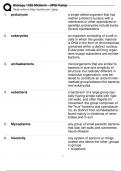-
1. Exam (elaborations) - Mcat demo test biology section review 2024 - 2025 questions and answers solved
-
2. Exam (elaborations) - Penn foster - biology lesson 5, plant and animal systems, and behavior, exam (700042r...
-
3. Exam (elaborations) - Penn foster proctored exam intro to biology exam 2024 - 2025 questions and answers
-
4. Exam (elaborations) - Samenvatting van methoden en statistiek samenvatting van methoden en statistiek 1ste ...
-
5. Exam (elaborations) - Slcc biology 1090 unit 1 exam 2024 - 2025 questions and answers solved
-
6. Exam (elaborations) - Wgu c190 intro to biology review 2024 - 2025 questions and answers solved
-
7. Exam (elaborations) - General biology final exam study guide review 2024 - 2025 questions and answers
-
8. Exam (elaborations) - Honors biology exam study guide questions and correct detailed answers
-
9. Exam (elaborations) - Honors biology semester 1 final exam review 2024 - 2025 questions and answers solved
-
10. Exam (elaborations) - Ksu biology 198 exam 3 cell biology review 2024 - 2025 questions and answers solved
-
11. Exam (elaborations) - Bio midterm barclay exam questions with detailed, (complete answers), 2024; 100% trus...
-
12. Exam (elaborations) - Biol 214 quiz & exam questions with detailed, (complete answers), 2024; 100% trusted ...
-
13. Exam (elaborations) - Biol 266 final exam exam questions with detailed, (complete answers), 2024; 100% trus...
-
14. Exam (elaborations) - Biology 102 final exam questions with detailed, (complete answers), 2024; 100% truste...
-
15. Exam (elaborations) - Biology 103 final exam exam questions with detailed, (complete answers), 2024; 100% t...
-
16. Exam (elaborations) - Biology 105 ncsu exam questions with detailed, (complete answers), 2024; 100% trusted...
-
17. Exam (elaborations) - Biology 105 plant exam 2 study guide exam questions with detailed, (complete answers)...
-
18. Exam (elaborations) - Bio cumulative exam retake 94- exam questions with detailed, (complete answers), 2024...
-
19. Exam (elaborations) - Bio exam 2 questions & answers
-
20. Exam (elaborations) - Bio exam 4 pearson exam questions with detailed, (complete answers), 2024; 100% trust...
-
21. Exam (elaborations) - Biology 211 exam 4 exam questions with detailed, (complete answers), 2024; 100% trust...
-
22. Exam (elaborations) - Biology 305 exam questions with detailed, (complete answers), 2024; 100% trusted comp...
-
23. Exam (elaborations) - Biology 1001 exam 2 dr.nita lsu exam questions with detailed, (complete answers), 202...
-
24. Exam (elaborations) - Biology 1104 midterm exam questions with detailed, (complete answers), 2024; 100% tru...
-
25. Exam (elaborations) - Biology 1108 exam questions with detailed, (complete answers), 2024; 100% trusted com...
-
26. Exam (elaborations) - Biology 1305 - final exam - harvill exam questions with detailed, (complete answers),...
-
27. Exam (elaborations) - Biology 111 tamu rao final exam questions with detailed, (complete answers), 2024; 10...
-
28. Exam (elaborations) - Biology 113 lab midterm exam questions with detailed, (complete answers), 2024; 100% ...
-
29. Exam (elaborations) - Biology 182 asu exam 1 exam questions with detailed, (complete answers), 2024; 100% t...
-
30. Exam (elaborations) - Biology 211 exam 1 - iowa state university
-
31. Exam (elaborations) - Biology b - for primavera and isucceedvhs entire class workbooks and checkpoints not ...
-
32. Exam (elaborations) - Biology ch 11 fifth edition brooker brcc 1033 exam questions with detailed, (complete...
-
33. Exam (elaborations) - Biology cumulative final exam exam questions with detailed, (complete answers), 2024;...
-
34. Exam (elaborations) - Biology entrance exam exam questions with detailed, (complete answers), 2024; 100% tr...
-
35. Exam (elaborations) - Biology exams 1-4 exam questions with detailed, (complete answers), 2024; 100% truste...
-
36. Exam (elaborations) - Biology final exam exam questions with detailed, (complete answers), 2024; 100% trust...
-
37. Exam (elaborations) - Biology 1320 midterm - upei kemp exam questions with detailed, (complete answers), 20...
-
38. Exam (elaborations) - Biology 1402 test 3 held exam questions with detailed, (complete answers), 2024; 100%...
-
39. Exam (elaborations) - Biology 2190 final exam study guide...chapters 7-10 and 14 _ complete
-
40. Exam (elaborations) - Biology- as level 2023 exam questions with detailed, (complete answers), 2024; 100% t...
-
41. Exam (elaborations) - Biology paper 2- b10 exam questions with detailed, (complete answers), 2024; 100% tru...
-
42. Exam (elaborations) - Biology praxis exam study quiz exam questions with detailed, (complete answers), 2024...
-
43. Exam (elaborations) - Biology pre-assessment - c190 exam questions with detailed, (complete answers), 2024;...
-
44. Exam (elaborations) - Biology pre-comp vocab terms exam questions with detailed, (complete answers), 2024; ...
-
45. Exam (elaborations) - Biology proctored exam penn foster. exam questions with detailed, (complete answers),...
-
46. Exam (elaborations) - Biology savvas semester exam exam questions with detailed, (complete answers), 2024; ...
-
47. Exam (elaborations) - Biology final lecture exam (cumulative) exam questions with detailed, (complete answe...
-
48. Exam (elaborations) - Biology final review 2 exam questions with detailed, (complete answers), 2024; 100% t...
-
49. Exam (elaborations) - Biology leap 2025 exam questions with detailed, (complete answers), 2024; 100% truste...
-
50. Exam (elaborations) - Biology lsue. exam questions with detailed, (complete answers), 2024; 100% trusted co...
-
51. Exam (elaborations) - Biology exam questions with detailed, (complete answers), 2024; 100% trusted complete...
-
Show more




